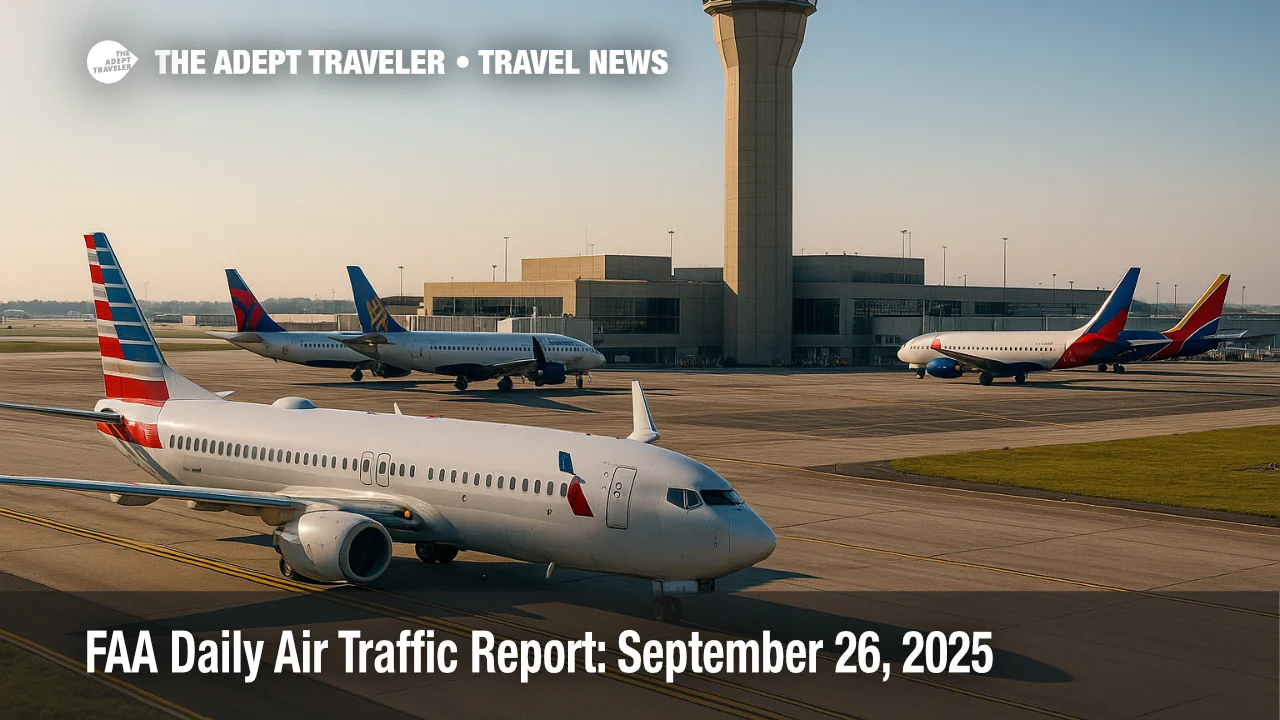FAA daily air traffic report: September 26, 2025

Low clouds along the coasts, afternoon thunderstorms in the Southeast, and breezy desert winds shape today's FAA daily air traffic report. The FAA highlights potential ground stops and ground delay programs this afternoon for Boston and several Florida hubs as storms build, while New York departures may slow at times due to a VIP flight restriction that limits a secondary runway option at John F. Kennedy International Airport.
Key points
- Why it matters: Weather and a VIP TFR could trigger GDPs and ground stops this afternoon.
- Travel impact: Expect periodic delays in New England, Florida, Atlanta, and Charlotte from 100 p.m. to 600 p.m. CDT.
- What's next: ATCSCC will update initiatives after its 8:15 a.m. CDT planning webinar.
- Low clouds may affect BOS, PHL, SFO, LAX, and SAN through the morning.
- Winds likely at LAS and PHX; thunderstorms possible in CLT, ATL, MCO, TPA, FLL, MIA.
Snapshot
The FAA's morning outlook calls for low ceilings in Boston, Philadelphia, San Francisco, Los Angeles, and San Diego, with storms building in Charlotte, Atlanta, and across Florida this afternoon. The Air Traffic Control System Command Center notes a VIP temporary flight restriction around New York that limits departure configurations at John F. Kennedy International Airport, raising the chance of departure delays during peak pushes. Western impacts ease at San Diego as ceilings lift above 2,000 feet, but San Francisco remains under monitor for short-term initiatives due to volume. Thunderstorms after 1:00 p.m. CDT could prompt capping, reroutes, or ground delay programs for Atlanta and Florida hubs.
Background
The FAA daily air traffic report summarizes expected nationwide constraints from weather, airspace restrictions, and airport construction. Command Center advisories translate those risks into time-boxed traffic management initiatives such as ground stops, ground delay programs, and structured reroutes. Today's plan includes potential initiatives in the Northeast, Mid-Atlantic, and Southeast tied to low clouds and convection, plus localized wind impacts in the Southwest. Ongoing construction continues at several large airports, including Boston Logan International Airport's Runway 9/27 closure, which can reduce arrival and departure capacity during certain wind and ceiling scenarios. Travelers should monitor airline alerts and watch for reroutes if storms develop along Florida's coastal airway structure.
Latest developments
Thunderstorms may trigger BOS and Florida GDPs after 1:00 p.m. CDT
ATCSCC's current operations plan lists multiple "possible" initiatives this afternoon: Boston ground stop or ground delay program expected after 100 p.m. CDT, with additional ground stops or delay programs possible for Miami, Fort Lauderdale, Tampa, and Orlando beginning after 100 p.m. to 500 p.m. CDT as storms build. Charlotte could see a ground stop after 300 p.m. CDT, and Atlanta is tagged for a potential ground stop or ground delay program after 1:00 p.m. CDT as thunderstorms develop. New York departures may be constrained at times due to a VIP TFR that removes a secondary departure runway at JFK. En-route thunderstorm impacts are possible across multiple Air Route Traffic Control Centers, and several structured reroute packages are on deck for the Northeast and Florida corridors.
Analysis
For morning travelers, the primary driver is marine stratus and low clouds, especially at Boston Logan International Airport, Philadelphia International Airport, and the California coast. That typically yields miles-in-trail or minor departure metering, improving by late morning as ceilings lift. The higher-risk window begins early afternoon when convection builds over the Carolinas, Georgia, and the Florida peninsula. These storms tend to pulse and line up along sea-breeze boundaries, periodically closing arrival gates and forcing capping, swaps, or escape routes that lengthen flight times. If anvils drift over departure corridors, expect brief ground stops that clear once cells move. The VIP TFR near New York can compound delays because JFK is planned to run 31L/31R departures without its secondary runway option; any push or taxi-out imbalance can ripple into LaGuardia and Newark departure fixes. Out West, San Francisco remains volume-sensitive, so even short-term initiatives can stack delays during banks. Net-net, the afternoon pattern favors scattered, hour-scale delays rather than a single, nationwide constraint, but BOS and Florida hubs have the highest probability of GDPs.
Final thoughts
Plan extra time if you are flying through Boston, Atlanta, Charlotte, or Florida hubs this afternoon, and watch for reroutes on Northeast and Florida corridors. Morning coastal low clouds should improve toward midday, but the later thunderstorm window carries the highest delay risk. For a fuller context, compare today's FAA daily air traffic report with recent patterns and your airline's alerts before you head to the airport.
FAA daily air traffic report: September 25, 2025 Italy air transport strike: minimum services and airport advisories
